
USS Monitor was an ironclad warship built for the Union Navy during the American Civil War and completed in early 1862, the first such ship commissioned by the Navy. Monitor played a central role in the Battle of Hampton Roads on 9 March under the command of Lieutenant John L. Worden, where she fought the casemate ironclad CSS Virginia to a stalemate. The design of the ship was distinguished by its revolving turret, which was designed by American inventor Theodore Timby; it was quickly duplicated and established the monitor class and type of armored warship built for the American Navy over the next several decades.

A postmark is a postal marking made on an envelope, parcel, postcard or the like, indicating the place, date and time that the item was delivered into the care of a postal service, or sometimes indicating where and when received or in transit. Modern postmarks are often applied simultaneously with the cancellation or killer that marks postage stamps as having been used. Sometimes a postmark alone is used to cancel stamps, and the two terms are often used interchangeably. Postmarks may be applied by handstamp or machine, using methods such as rollers or inkjets, while digital postmarks are a recent innovation.
A first day of issue cover or first day cover (FDC) is a postage stamp on a cover, postal card or stamped envelope franked on the first day the issue is authorized for use within the country or territory of the stamp-issuing authority. Sometimes the issue is made from a temporary or permanent foreign or overseas office. Covers that are postmarked at sea or their next port of call will carry a Paquebot postmark. There will usually be a first day of issue postmark, frequently a pictorial cancellation, indicating the city and date where the item was first issued, and "first day of issue" is often used to refer to this postmark. Depending on the policy of the nation issuing the stamp, official first day postmarks may sometimes be applied to covers weeks or months after the date indicated.
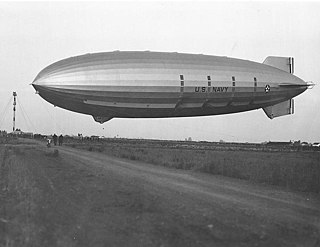
USS Akron (ZRS-4) was a helium-filled rigid airship of the U.S. Navy, the lead ship of her class, which operated between September 1931 and April 1933. It was the world's first purpose-built flying aircraft carrier, carrying F9C Sparrowhawk fighter planes, which could be launched and recovered while it was in flight. With an overall length of 785 ft (239 m), Akron and her sister ship Macon were among the largest flying objects ever built. Although LZ 129 Hindenburg and LZ 130 Graf Zeppelin II were some 18 ft (5.5 m) longer and slightly more voluminous, the two German airships were filled with hydrogen, and so the two US Navy craft still hold the world record for the largest helium-filled airships.

USS Langley (CV-1/AV-3) was the United States Navy's first aircraft carrier, converted in 1920 from the collier USS Jupiter, and also the US Navy's first turbo-electric-powered ship. Conversion of another collier was planned but canceled when the Washington Naval Treaty required the cancellation of the partially built Lexington-class battlecruisers Lexington and Saratoga, freeing up their hulls for conversion to the aircraft carriers Lexington and Saratoga. Langley was named after Samuel Langley, an American aviation pioneer. Following another conversion to a seaplane tender, Langley fought in World War II. On 27 February 1942, while ferrying a cargo of USAAF P-40s to Java, she was attacked by nine twin-engine Japanese bombers of the Japanese 21st and 23rd naval air flotillas and so badly damaged that she had to be scuttled by her escorts. She was also the only carrier of her class.
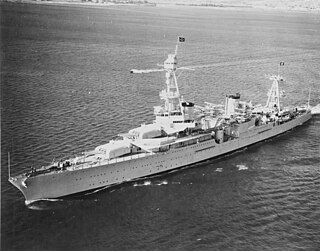
USS Houston (CL/CA-30), was a Northampton-class cruiser of the United States Navy. She was the second Navy ship to bear the name "Houston".

USS Chicago (CL/CA-29) was a Northampton-class cruiser of the United States Navy that served in the Pacific Theater in the early years of World War II. She was the second US Navy ship to be named after the city of Chicago. After surviving a midget submarine attack at Sydney Harbour and serving in battle at the Coral Sea and Savo Island in 1942, she was sunk by Japanese aerial torpedoes in the Battle of Rennell Island, in the Solomon Islands, on 30 January 1943.

USS Bunker Hill was one of 24 Essex-class aircraft carriers built during World War II for the United States Navy. The ship was named for the Battle of Bunker Hill in the American Revolutionary War. Commissioned in May 1943 and sent to the Pacific Theater of Operations, the ship participated in battles in the Southwest Pacific, Central Pacific and the drive toward Japan through Iwo Jima and Okinawa, and air raids on the Japanese homeland.

Ernest Joseph King was a fleet admiral in the United States Navy who served as Commander in Chief, United States Fleet (COMINCH) and Chief of Naval Operations (CNO) during World War II. He directed the United States Navy's operations, planning, and administration and was a member of the Joint Chiefs of Staff and was the U.S. Navy's second-most senior officer in World War II after Fleet Admiral William D. Leahy, who served as Chairman of the Joint Chiefs of Staff.

A philatelic cover is an envelope prepared with a stamp(s) and address and sent through the mail delivery system for the purpose of creating a collectible item. Stamp collectors began to send mail to each other and to themselves early on, and philatelic mail is known from the late 19th century onward. While some collectors specialize in philatelic covers, especially first day covers and cacheted covers, others regard them as contrived objects that are not reflective of real-world usage, and often will pay a higher price for a cover that represents genuine commercial use. However, mail sent by stamp collectors is no less a genuine article of postage than is mail sent with no concern of seeing the mailed item again. Philatelic covers include mail from first airmail flight and first day of stamp issues ceremonies. Over the years there have been numerous Expositions where special postmarks are made and where a post office is set up where mail can be sent from on the given date of the Expo'. Like any other genuine item of mail these covers include postage stamps and postmarks of the time period and were processed and delivered by an official postal system. Often a philatelic cover will have more historical significance than randomly mailed covers as philatelic covers are also often mailed from the location on the date of an important or noteworthy event, like an inauguration or a space launch.

USS Macon (ZRS-5) was a rigid airship built and operated by the United States Navy for scouting and served as a "flying aircraft carrier", carrying up to five single-seat Curtiss F9C Sparrowhawk parasite biplanes for scouting or two-seat Fleet N2Y-1s for training. In service for less than two years, the Macon was damaged in a storm and lost off California's Big Sur coast in February 1935, though most of the crew were saved. The wreckage is listed as the USS Macon Airship Remains on the U.S. National Register of Historic Places.

Montgomery Meigs Taylor was an admiral in the United States Navy. He served in the Navy from 1890 to 1933, fought in the Battle of Manila Bay during the Spanish–American War in 1898, and later commanded the Control Fleet and the Scouting Fleet. He served as commander-in-chief of the United States Asiatic Fleet from 1931 to 1933.

The Yangtze Patrol, also known as the Yangtze River Patrol Force, Yangtze River Patrol, YangPat and ComYangPat, was a prolonged naval operation from 1854–1949 to protect American interests in the Yangtze River's treaty ports. The Yangtze Patrol also patrolled the coastal waters of China where they protected U.S. citizens, their property, and Christian missionaries.

The Aggressive-class minesweepers are a class of US-built minesweepers. They are designated as MSO, distinguishing them from the smaller coastal MSCs and inshore MSIs. Besides the US Navy, this class of vessels has also been used by the Belgian Navy and the Norwegian Navy, among others.
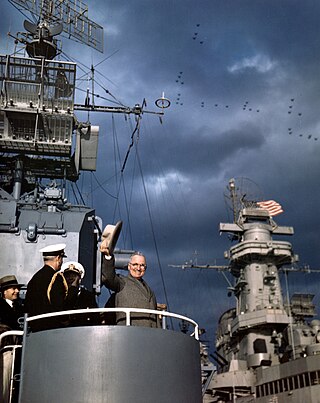
A Naval Review is an event where select vessels and assets of the United States Navy are paraded to be reviewed by the President of the United States or the Secretary of the Navy. Due to the geographic distance separating the modern U.S. Navy and the deployment rotations of a various ships within a fleet, it would be exceedingly difficult to imagine a situation where even an entire numbered fleet could be presented at one event, to say nothing of the physical cost and logistical requirements to support over 460 ships exceeding 3.4 million tons displacement.

Operation Magic Carpet was the post-World War II operation by the War Shipping Administration to repatriate over eight million American military personnel from the European, Pacific, and Asian theaters. Hundreds of Liberty ships, Victory ships, and troop transports began repatriating soldiers from Europe in June 1945. Beginning in October 1945, over 370 navy ships were used for repatriation duties in the Pacific. Warships, such as aircraft carriers, battleships, hospital ships, and large numbers of assault transports were used. The European phase of Operation Magic Carpet concluded in February 1946 while the Pacific phase continued until September 1946.
The Universal Ship Cancellation Society (USCS) is an international philatelic non-profit organization with an interest in postmarks and covers from all maritime services. Founded in 1932, the USCS is one of the oldest specialized postal history societies in the world and the only organization in the United States devoted to navy and maritime covers.

Henry Croskey Mustin was a pioneering naval aviator who undertook the task of establishing the first Naval Aeronautic Station on the site of the abandoned Navy Yard at Warrington, Florida in 1914. He was designated Navy Air Pilot No. 3 and later Naval Aviator No. 11. Two U.S. Navy destroyers have borne the name Mustin in honor of Captain Mustin and his descendants, three of whom have served as flag officers.
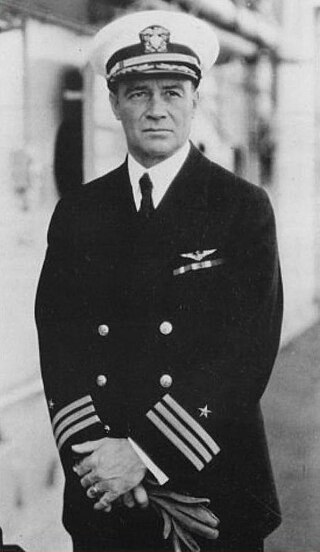
Kenneth Whiting was a United States Navy officer who was a pioneer in submarines and is best known for his lengthy career as a pioneering naval aviator. During World War I, he commanded the first American military force to arrive in Europe for combat. After the war, he was instrumental in development of the aircraft carrier in the United States, where he sometimes is known as the U.S. Navy's "father of the aircraft carrier." He was involved in some way in the design or construction of five of the first six U.S. Navy aircraft carriers, and served as acting commanding officer of the first carrier to enter U.S. Navy service and as executive officer of the first two American carriers. In the earliest days of the U.S. Navy's development of an aircraft carrier force, he led many shipboard innovations still in use aboard carriers today.
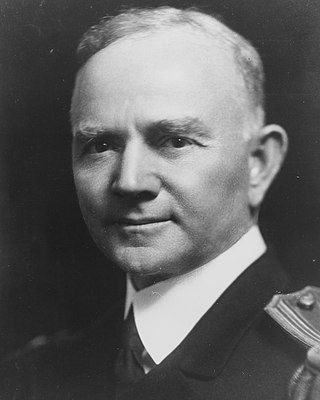
Admiral Richard Henry Leigh CBE was a United States Navy officer who served during the late 19th and early 20th century. His service included active duty in the Spanish–American War, Philippine–American War, American Intervention in China, World War I, as well as numerous smaller actions in South America. His service during World War I led to the further development of hydrophone technology to hunt submarines. Following World War I Leigh rose to the rank of four-star admiral and served as Commander, Battle Force, U.S. Fleet (COMBATFOR) from 1931 to 1932 and as Commander in Chief, U.S. Fleet (CINCUS) from 1932 to 1933.






















